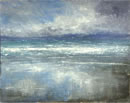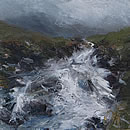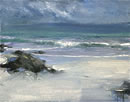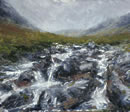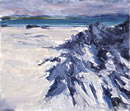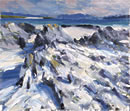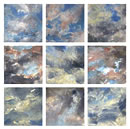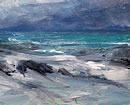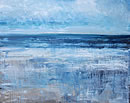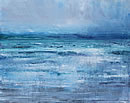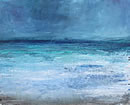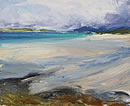In Wild Places
Landscape painting has an impressive history and tradition in Britain and it is encouraging to find there are still artists who feel an affnity with a particular type of landscape and are able to communicate this in an original and interesting way. For Jonathan Shearer, it is the awesome power and poetry of wild, unspoilt landscapes that is his inspiration and, as with Turner, McCulloch and McTaggart (artists whom he particularly admires), his work skillfully combines perception, emotion and expression with a sensitive concern for painterly qualities.
The connection with the landscape, its history and special sense of place, are aspects that are fundamental to Jonathan’s work, such that every painting originates from oil sketches and drawings made on site. For him, the advantages of working on site lie as much in the physical and emotional experience of being there as in the opportunity to capture an expression of those experiences in paint.
Remote, and invariably shaped by the drama of light and weather, his landscapes belong to an undisturbed, sublime wilderness. They are landscapes dominated by natural forces and, in turn, in his large canvases he works with a similar sense of urgency and energy to convey the distinctive mood and atmosphere of each scene. With their ‘ebb and flow’ of paint, these are evocative, engaging landscapes, but more than this, they are paintings charged with a strong spiritual quality.
Working on Site
‘Speed is essential when working outside – if you spend too much time on a sketch or painting, you lose the sense of what is happening, ’Jonathan explains. ‘I like each painting to be readily identifiable to the particular location, yet equally it must be true to my feelings and response, which I think gives it an integrity. Consequently the result won’t necessarily be an exact representation of what I saw. And although my aim is to capture the moment, conversely I also think there is a timeless quality about such scenes.
‘Generally my subjects are wild places, away from the obvious tourist spots. Ideally, I look for landscapes unaffected by man, although with forestry and other activities that sort of primeval landscape is increasingly diffcult to find. Occasionally I do include man-made elements–perhaps the remains of a stone wall, a croft or some farm buildings–and these create a telling sense of scale within the vastness of the landscape. But what I prefer is that feeling of isolation; of being submerged in a landscape that has a resonance of history, although perhaps no visual evidence of mankind.’
In the last few years Jonathan’s paintings have been inspired mostly by locations in the Highlands and west coast of Scotland, including sites on Mull and Iona. He travels all over Scotland, usually concentrating on a different area at a time and so building up a body of work for each solo exhibition. Other favourite locations include the Crianlarich Hills, Rannoch Moor and Glen Coe, all of which are not far from his studio in Perthshire.
‘I need to get to know a place before I can paint it, ’Jonathan says, ‘and initially I spend a lot of time walking, looking and contemplating. Also, I like to revisit locations at different times of the year and in different weather conditions.The weather is a major influence in my work and usually I am looking for something dramatic. If it is a calm, sunny day I tend to find it a bit bland! I have also painted in other remote areas of the country, including the Yorkshire Moors, as well as in Andalucía, Spain.
‘The choice of subject is an instinctive thing. When I am in the landscape I know where I want to paint–it just feels right. I take all the necessary equipment with me, including a portable easel, small canvas boards and a sketchbook. Sometimes I walk for long distances, at other times, particularly if the weather is bad, I work from the side of the road or from the back of my van. The van is fitted out as a sort of travelling studio, with racks to hold paintings and other equipment.’
On site Jonathan works on small canvas-covered boards or canvases, often just 5 x 7 inches. (13 x 18 cms) in size but sometimes slightly larger and proportionately more horizontal in format. As in the studio, essentially he uses a wet-into-wet technique, painting onto a surface that is initially brushed all over with a mixture of linseed oil and Zest-it (an environmentally-friendly alternative to turpentine). The wet surface gives him the freedom to apply paint and move it about very quickly; to draw with the paint and respond sensitively to the unfolding mood of the subject before him.
‘A small oil study of this type will normally take about ten minutes,’ he explains. ‘The biggest hurdle for me to overcome is the temptation to start adding detail, so I limit myself to a certain amount of time. The studies will be related, but not necessarily made at the same location. Like the weather, I am fairly restless, and if I exhaust the potential at one site, I move on elsewhere. From a day’s work I usually produce between ten and thirty oil sketches, and as additional reference I take digital photographs.
Vigour and Expression
From the groups of studies made on site Jonathan selects the ones that will be useful in the studio to develop as larger paintings which, as with Rannoch moor, Reflections for example, can measure up to 7 ft or more in size. For these paintings he uses stretched linen canvas which, as explained, is wetted all over with a mixture of linseed oil and Zest-it. To suit the scale and vigour of the work he uses very large brushes, including hogs, rounds, household and glazing brushes (he has around 200 brushes in his studio), as well as rags and his hands and fingers. His palette normally includes sixteen colours, although this can vary, depending on the particular subject matter.The sequence of colours (anti-clockwise, from the bottom-left of the palette) is: titanium white, lemon yellow, yellow ochre, raw sienna, burnt umber, raw umber, burnt sienna, vermilion red, cadmium red, ultramarine blue, cobalt blue, cerulean blue, viridian green, terra verte and, sometimes, alizarin crimson.
‘Attempting to copy the oil sketch on a much larger scale simply would not work,’ Jonathan comments. ‘The painting would lose its vitality. Instead, I use the sketch as a reference and combine this with my feelings and recollections of the subject, which leads to a much more exciting and interesting result. ‘Again, I work frantically and energetically; I can block in the basics of the large canvas within a couple of hours. Generally the brushwork is bold and gestural. Sometimes the paint runs and drips, but I am quite open to accept accidental effects of that kind if they contribute to the painting.
‘Finished or not, there comes a point when it is necessary to put the painting aside for a while and work on something else. I may leave it for a week or perhaps as long as two months. Then I will reassess it and decide whether any further work is required. If so, the likelihood is that the painting will completely change. But I avoid further work if the momentum is lost, because in my view painting must always be an emotional, vigorously expressive process.’
Robin Capon
Art Journalist
Originally printed in The Artist Magazine, May 2009 |
Download exhibition catalogue
(Adobe Reader format, 1.2 Mb)
Education |
1989
–1993
|
Grays School of Art Robert Gordons University, Aberdeen: BA(Hons) Painting & Drawing |
1995
–1996 |
Cyprus College of Art: Postgrad Dip: Painting & Drawing |
| |
|
Awards |
| 2005 |
Fundacion Valparaso. Residency, Spain |
| 1995 |
Commendation, Aberdeen Artists Exhibition |
| 1993 |
John Kinross Scholarship to Florence |
| |
Royal Scottish Academy, Sir Robin Phillipson Memorial Medal |
| |
Royal Scottish Academy, 1st Prize, Grays Sketch Club Exhibition |
| |
Aberdeen Art Gallery |
| |
|
Solo Exhibitions |
| 2010 |
In Wild Places, MacLean Fine Art, at The Air Gallery, London |
| 2009 |
Atmosphere and Light, Strathearn Galley, Crieff |
| 2008 |
New paintings, MacLean Fine Art, at the Arndean Gallery, Cork Street, London |
| 2007 |
Wild Places, Strathearn Gallery, Crieff
|
| |
Travels in Yorkshire, Lund Gallery, Yorkshire |
| |
Leith Gallery, Edinburgh |
| 2005 |
New Paintings, Scotland & Andalucia, Patriothall Gallery, Edinburgh |
| |
The Sublime Wilderness, Castle Gallery, Inverness |
| 2004 |
Castlegatehouse Gallery, Cockermouth, Cumbria |
| 2003 |
Scottish Landscapes, Castle Gallery, Inverness |
| 2002 |
Castlegatehouse Gallery, Cockermouth, Cumbria |
| 2001 |
Reynolds Gallery, Edinburgh |
| |
Art London, Mainhill Gallery |
| 1996 |
The Mosque, Cyprus College of Art |
| |
|
Selected Group Exhibitions |
| 2009 |
The Meffan Gallery, Forfar |
| 2008 |
Park Gallery, Alkirk |
| |
Strathearn Gallery, Crieff |
| 2007 |
Highland Fringe (Highland 2007), Castle Gallery, Inverness |
| 2006 |
Land & Sea, Strathearn Gallery, Force of Nature, Leith Gallery |
| 2005 |
Mountain Men, Castlegatehouse Gallery |
| 2004 |
Saltire, Three Scottish Artists, Campden Gallery, Gloucestershire
|
| |
Northern Light, Leith Gallery
|
| |
Royal Scottish Academy Annual Exhibition
|
| |
Big Skies, Deep Lochs & Clear Skies, Strathearn Gallery |
| 2003 |
Royal College of Physicians
|
| |
Edinburgh
Paisley Art Institute
|
| |
Rough Bounds, Strathearn Gallery
|
| |
Castle Gallery, Inverness Curator’s Choice, |
| |
Castlegatehouse Gallery |
| 2002 |
Hip to be Square, Leith Gallery |
| |
Scottish Landscapes, Strathearn Gallery |
| 2001 |
RSW Annual Exhibition, RSA, Edinburgh
|
| |
Both Sides of the Border, Art Edinburgh, Aberdeen Art Gallery |
| 1999 |
Northern Connections, ARI, Aberdeen |
| 1998 |
SSA Exhibition, RSA, Edinburgh |
| 1997 |
4 Elements, Chessels Gallery, Edinburgh |
| 1996 |
Apocolypse Gallery, Nicosia, Cyprus |
| |
Morphi Gallery, Limassol, Cyprus |
| 1995 |
Aberdeen Artists Annual Exhibition, Aberdeen Art Gallery |
| |
|
Charity Exhibitions |
| 2007 |
Scottish Art, Air Gallery, London |
| 2006 |
Scottish Art, Air Gallery, London |
| |
|
Art Fairs |
| 2008 |
London Art Fair, MacLean Fine Art |
| 2007 |
Art London, MacLean Fine Art |
| 2005 |
Glasgow Art Fair, Compass Gallery |
| |
London Art Fair, Castle Gallery |
| 2002 |
Glasgow Art Fair, Mainhill Gallery |
| 2001 |
Art on Paper, Royal College of Art |
| 2000 |
London Art Fair, Compass Gallery |
| |
|
Collections |
| |
British Midland Airways |
| |
Cyprus College of Art |
| |
Royal Scottish Academy |
| |
Grays School of Art |
| |
Royal Cornhill Hospital |
| |
Highland Council |
| |
Private collections throughout Britain, America, Cyprus and Asia |
| |
|
|


















